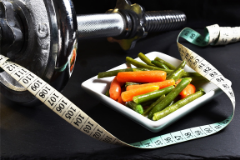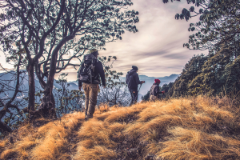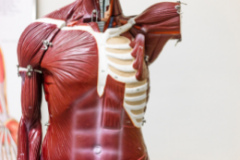PHYSICAL EDUCATION & HEALTH DOMAIN
Stacey Hockin
Physical Education & Health Instructional Leader
Health and Physical Education focuses on students enhancing their own and others’ health and wellbeing and physical activity participation. Research in fields such as sociology, physiology, nutrition, biomechanics and psychology informs what we understand about healthy, safe and active choices. Health and Physical Education offers you an experiential curriculum that is contemporary, relevant, challenging, enjoyable and physically active.
As a foundation for lifelong physical activity participation and enhanced performance, you develop proficiency in movement skills, physical activities and movement concepts, as well as acquire an understanding of the science behind how the body moves. In doing so, you develop an appreciation of the significance of physical activity, outdoor recreation and sport both in Australian society and globally.
Health and Human Development 3-4

- Examine the progression of public health in Australia
- Investigate the health system’s role in promoting wellbeing
- Analyse factors that contribute to health inequalities
Subject Code: V2PHD
Year Level: 12
Unit 3: Australia’s health in a globalised world
This area of study explores health and wellbeing and illness as complex, dynamic and subjective concepts. While the major focus is on the health of Australians, this unit also emphasises that Australia’s health is not isolated from the rest of the world.
You develop an understanding of the indicators used to measure and evaluate health status, and the factors that contribute to variations between population groups in Australia. You examine the progression of public health in Australia since 1900, noting global changes and influences such as the Ottawa Charter for Health Promotion.
We investigate the Australian health system and its role in promoting health and wellbeing. You conduct a detailed study on a successful health promotion campaign or program, and inquire into priorities for health improvements in Australia.
What does this mean for me?
You should be able to explain the complex, dynamic and global nature of health and wellbeing, interpret and apply Australia’s health status data and analyse variations in health status. You explain changes to public health approaches, analyse improvements in population health over time and evaluate health promotion strategies.
Unit 4: Health and Human Development in a global context
You look at similarities and differences in major burdens of disease in low-middle-and high income countries, including Australia. We investigate a range of factors that contribute to health inequalities and study the concepts of sustainability, human development and the Human Development Index to further their understanding of health in a global context. You consider the global reach of product marketing and inquire into the effects of particular global trends on health and wellbeing.
We look at the rationale, objectives and interdependencies of the UN’s Sustainable Development Goals, focusing on their promotion of health and wellbeing and human development. You investigate the priorities and work of the WHO and evaluate Australia’s aid program and the role of non-government organisations, selecting one aid program for detailed research and analysis.
What does this mean for me?
You analyse similarities and differences in health status and burden of disease globally and the factors that contribute to differences in health and wellbeing. You review the relationships between the SDGs and their role in the promotion of health and human development, and evaluate the effectiveness of global aid programs.
Assessment
- Course work
- Outcome tests
- End of semester exam
What sort of student would like Health and Human Development?
Someone who:
- Has an interest in how humans change over their lifespan and wants to explore the varying factors that influence our health and development and that of different people
- Wants to learn more about what is being done globally to improve the health of the human race
- Is interested in health promotion and world issues.
Pre-Requisites
Nil. However, completing any Pathways PE/Health subject can be useful.
Outdoor and Environmental Studies 3-4

- Focus on the relationships between humans and nature
- Learn through practical outdoor experiences
- Explore the sustainable use and management of the environment
Subject Code: V2POE
Year Level: 12
Unit 3: Relationships with outdoor environments
Our focus is the ecological, historical and social contexts of relationships between humans and the outdoors in Australia. Case studies of impacts are examined in the context of the changing nature of human relationships with outdoor environments in Australia. We also examine the dynamic nature of relationships between humans and their environment.
You are involved in one or more experiences in outdoor environments, including areas where there is evidence of human interaction. Through these practical experiences you have the basis for comparison and reflection, and opportunities to develop theoretical knowledge and skills.
Field trips include a three-day experience through the local region examining effects of different population groups on the environment.
Field trips are vital components of the unit as they are directly related to SAC tasks.
Unit 4: Sustainable outdoor relationships
We explore the sustainable use and management of outdoor environments by current day Australians, and in the past by indigenous Australians and early settlers. You examine the contemporary state of environments in Australia, consider the importance of healthy outdoor environments, and examine the issues in relation to the capacity of the outdoors to support the future needs of the Australian population.
Classroom learning and a field trip focus on current practices and sustainable use by all user groups. The role of society in developing sustainable use practices and processes to regulate use of outdoor environments is studied.
There is one field trip.
Assessment
- Course work
- Research assignments
- Field trip planning, participation and leading
- Outcome tests and SACs
- End of year exam
What sort of student would like Outdoor and Environmental Studies?
Someone who:
- Is interested in outdoor activities
- Has a desire to learn from practical experiences
- Has an awareness of environmental issues
- Likes to contribute to improvements in the outdoor environments we visit
- Can work independently and use information from a number of sources to complete learning tasks.
Pre-requisites
Nil. However, students are strongly encouraged to have completed Outdoor Education in Pathways (9-10).
Other Considerations
*This subject incurs additional costs.
Physical Education 3-4

- Application of biomechanical and skill acquisition principles in sport
- How does the body produce energy for sporting performance?
- What factors cause fatigue?
Subject Code: V2PPE
Year Level: 12
Unit 3: Movement skills and energy for physical activity
We introduce you to the biomechanical and skill acquisition principles used to analyse human movement skills and energy production from a physiological perspective. You use a variety of tools and techniques to analyse movement skills and apply biomechanical and skill acquisition principles to improve and refine movement in physical activity, sport and exercise.
We investigate the relative contribution and interplay of the three energy systems to performance in physical activity, sport and exercise. In particular, you investigate the characteristics of each system and the interplay of the systems during physical activity. You explore the causes of fatigue and consider different strategies used to postpone fatigue and promote recovery.
What does this mean for me?
You collect and analyse information from, and participate in, a variety of physical activities to develop and refine movement skills from a coaching perspective, through the application of biomechanical and skill acquisition principles.
You use data collected in practical activities to analyse how the major body and energy systems work together to enable movements to occur, and explain the factors causing fatigue and suitable recovery strategies.
Unit 4: Training to improve performance
We analyse movement skills from a physiological, psychological and sociocultural perspective, and apply relevant training principles and methods to improve performance within physical activity at an individual, club and elite level.
We consider the physiological, psychological and sociological requirements of training to design and evaluate an effective training program. You participate in a variety of training sessions designed to improve or maintain fitness and evaluate the effectiveness of different training methods.
What does this mean for me?
You use data from an activity analysis and determine the fitness requirements of a selected physical activity. You participate in a series of fitness tests and design a suitable training program using relevant training principles and methods from a practical and theoretical perspective.
Assessment
- Course work
- Outcome tests and SACs
- End of year exam
What sort of student would like Physical Education?
Someone who:
- Is active and enjoys physical activity
- Wants to learn about the body systems
- Has an interest in factors that influence physical activity
- Wishes to develop and undertake a training program.
Pre-Requisites
Nil. However, a Pathways subject such as Health and Wellbeing, Pre VCE Health and Human Development, or Physical Education (Boys or Girls) can be useful.
